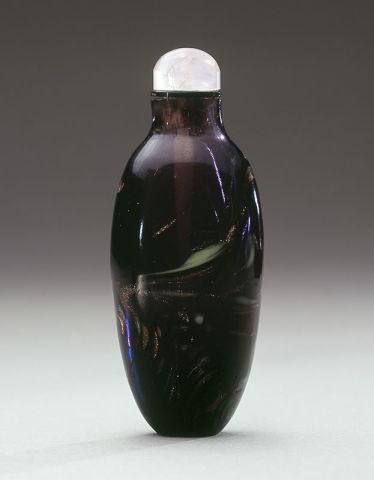
Bottle ID: 00684
PURPLE, DARK SUFFUSED W/AVENTURINE SPLASHES & SWIRLS
Date: 1740-1780
Height: 61 mm
Glass, of slender elongated ovoid form with shoulders tapering to a wide everted mouth, and with a slightly concave foot, the dark purple body suffused with aventurine splashes and swirls of yellow and blue.
Possibly Imperial; possibly attributed to the Palace Workshops, Beijing.
Similar Examples:
Lawrence, Clare. 1993 Chinese Snuff Bottles Engagement Diary, 1992.
Sotheby's, New York, April 16, 1985 lot 49, Collection of Alice B. McReynolds, Part II.
Sotheby's, Hong Kong, October 28, 1993, lot 1010, Collection of Eric Young, Part IV.
Provenance:
Asian Art Studio
Bonhams & Butterfields
Exhibited:
Annual Convention ICSBS Toronto, October 2007
This is a rare ground color for this small group of glass bottles, almost all of which are of a slender elongated oval shape. Other examples use the same swirly tones of yellow, blue and purple in different combinations depending on the ground color, but all use irregular splashes of aventurine giving an eighteenth century glass bottle a highly contemporary look. Other ground colors recorded are opaque bright yellow and opaque blue. In the Crane example, the purple body is almost dark enough to look as though it is black out of the light. The design of this group owe their allegiance to Venetian glass of the same period, which would have found its way into the Palace as presentation pieces from European leaders to the Emperor.
Aventurine glass is made using inclusions of copper powder within the glass itself. It was first produced in Murano, Italy before 1700 in the middle of the seventeenth century by the famous Miotto family of glassmakers, and despite the attempt by the family to keep the recipe a secret, it had obviously made its way to China by the mid-eighteenth century. The Archives of the Imperial Household Department note in 1744 'golden star' glass, but it is not clear whether this was a European import or whether it was being made in China at the time. The first entry in the Archives in 1744 lists a wumu inkstick stand with golden star glass inlay which can only be of Chinese origin. However, in the same year, the Inscription Workshop is asked to inscribe a reign mark on two 'golden star' cases for set squares - this is more likely to have been a 'foreign' import.
< Back to full list
 English
English 中文
中文